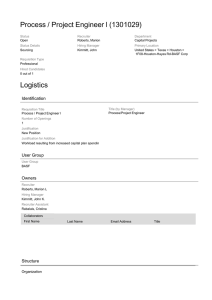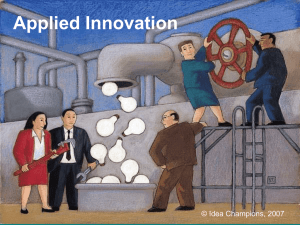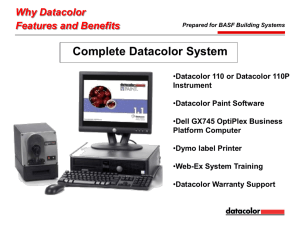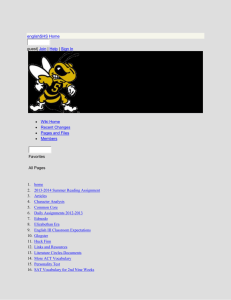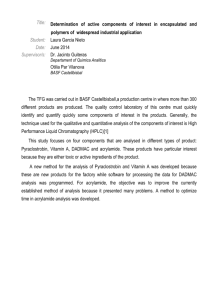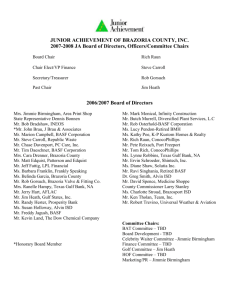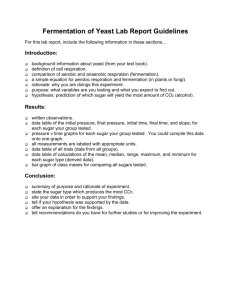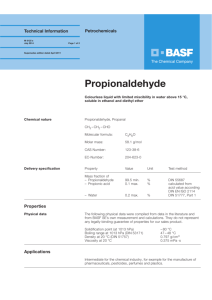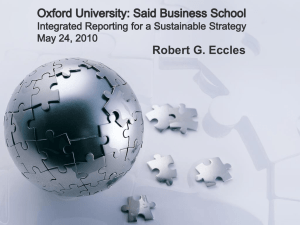LOW - COST FERMENTATION GRADE GLUCOSE
advertisement
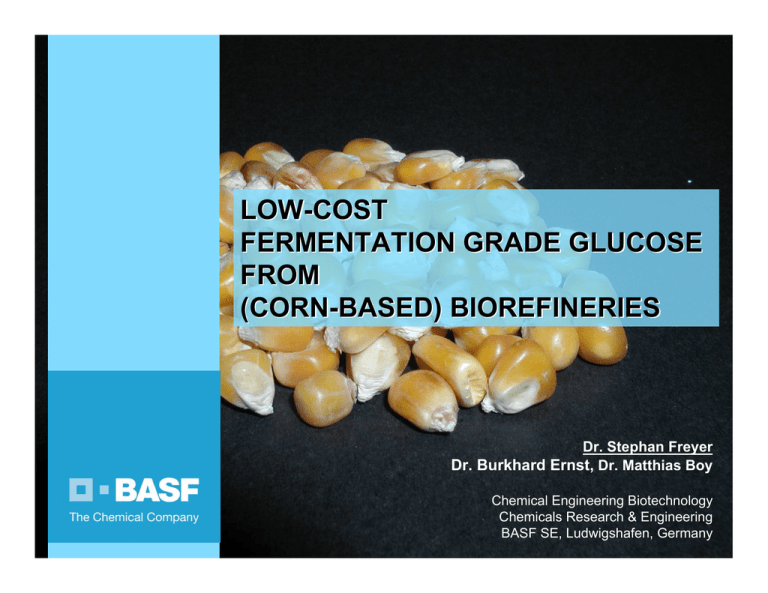
LOW-COST FERMENTATION GRADE GLUCOSE FROM (CORN-BASED) BIOREFINERIES Dr. Stephan Freyer Dr. Burkhard Ernst, Dr. Matthias Boy Chemical Engineering Biotechnology Chemicals Research & Engineering BASF SE, Ludwigshafen, Germany BASF at a Glance BASF – The Chemical Company The world’s leading chemical company Offers intelligent system solutions and high-value products for almost all industries Sales 2008: € 62,3 billion Income from operations (EBIT) 2008: € 6.46 billion Employees (December 31, 2008): ca. 97,000 Dr. Stephan Freyer, BASF SE 2 The Verbund Site Ludwigshafen The world’s largest integrated chemical complex “Verbund” – a Management Philosophy “They pump in natural gas, oil and salt at one end, make everything and the by-products are recycled. There is very little actual waste.” (The Times, Nov. 1998) •Manufactures high-value products in a dense network of plants • est. 1865 • size: 10 km² ~ 2500acres • > 30.000 employees on-site • > 200 plants • > 8.5 mil. tons of products per year • > 2000 km over ground pipes • 115 km roads; 211 km rail Dr. Stephan Freyer, BASF SE 3 Motivation for development of a biorefinery Access to low-cost sugar is a prerequisite for chemicals from renewables. BASF‘s current situation is characterized by: Access to sugar at market price only Regions of low cost sugar production are distant from chemical markets BASF production sites Current technologies for sugar production are capital-intensive exceed BASF‘s demand for sugar ¨ Develop own access to sugar at producer economics, even at moderate scale. Dr. Stephan Freyer, BASF SE 4 Fermentation sugar sources Comparison of existing technologies 1 Process Sugar mill Wet-milling Dry-milling (BioEtOH) Raw material Sugar cane Corn Corn Fermentation sugar purity > 98 % Autonomy of sugar production Low Low High Raw material costs World market World market World market Investment costs Low High1 Low Production costs Low Low1 Low > 99% (food-grade) ~ 70% World-scale plants (>1.5 Mio tons/a crushing capacity) Dr. Stephan Freyer, BASF SE 5 Process idea and overview Basic flow scheme of bioethanol production Corn Milling Liquefaction Saccharification α-Amylase β-Glucoamylase Fermentation Destillation Whole stillage Solid-/Liquid-Separ. Thin stillage Concentration Biomass & Solids Ethanol Drying Syrup DDGS Dr. Stephan Freyer, BASF SE 6 Process idea and overview Adaption for fine chemical fermentation processes Corn Optimized process Milling Liquefaction Saccharification α-Amylase β-Glucoamylase Fermentation Biomass & solids Solid-/Liquid-Separ. Downstreaming Fine chemicals Thin stillage Concentration Syrup Drying DDGS-equivalent co-product (e.g. amino acids, vitamins, enzyms, ...) Dr. Stephan Freyer, BASF SE 7 Process idea and overview Pilot-scale development Overall view pilot plant Dr. Stephan Freyer, BASF SE 8 Process idea and overview Liquefaction & saccharification Detailed view pilot plant Dr. Stephan Freyer, BASF SE Mashing 1st liquefaction 2nd liquefaction Saccharification 9 Process idea and overview Fermentation Fermentation 300 L Dr. Stephan Freyer, BASF SE Fermentation 2400 L 10 Process idea and overview Solid/liquid separation Centrifugal separation Dr. Stephan Freyer, BASF SE 11 Process idea and overview Drying Drying equipment Dry co-roduct Dr. Stephan Freyer, BASF SE 12 Glucose production cost structure Raw materials incl. corn Variable costs Fixed costs Glucose production costs Netraw material costs Co-products of corn-processing (and fermentation) Dr. Stephan Freyer, BASF SE 13 Fermentation sugar sources Comparison of existing technologies & BASF process 1 Process Sugar mill Wet-milling Dry-milling (BioEtOH) BASF process Raw material Sugar cane Corn Corn Corn Fermentation sugar purity > 98 % ~ 70% > 90% Autonomy of sugar production Low Low High High Raw material costs World market World market World market World market Investment costs Low High1 Low Medium Production costs Low Low1 Low Low > 99% (food-grade) World-scale plants (>1.5 Mio tons/a crushing capacity) Dr. Stephan Freyer, BASF SE 14 Conclusion corn-based biorefinery Successful development of a process for the production of glucose. A high performing fermentation sugar source Medium investment costs Low glucose costs, even at moderate production scale Backward-integration to cheap sugar at production sites worldwide Short-term realization of the process is possible worldwide. Dr. Stephan Freyer, BASF SE 15 2nd generation biorefinery concept biofuel / chemicals production via fractionation why fractionation? biomass tailor-made conversion conditions for each stream fractionation ■ space time yield ■ capital investment monomerisation ■ flexibility hemicellulose conversion cellulose lignin biobased product Dr. Stephan Freyer, BASF SE Source cartoon: Faix & Lehnen 16 Example: biomass pretreatment ionic liquids ■ liquid below 100 °C ■ non flammable ■ immiscible with many organic solvents ■ BASF know-how & production ■ various emerging applications ■ dissolution of (ligno-)cellulose ■ exclusive license from the University of Alabama (patents of Prof. Rogers) Dr. Stephan Freyer, BASF SE 17 Example: biomass pretreatment biorefinery with ionic liquids screening of >50 ILs solution in IL EtOH 1. precipitation amorphous cellulose rich fraction 2. precipitation lignin fraction H2 O screening of parameters: - temperature - precipitating agent - water content of the IL - precipitation protocol series of experiments in closed process cycles two patents filed: WO 2008090155 WO 2008090156 enzymatic hydrolysis Dr. Stephan Freyer, BASF SE 18 Example: biomass pretreatment digestion of switchgrass by cellulases 80 _ glucose yield [%] OAc IL-treated switchgrass 60 N + N EMIM OAc 40 20 untreated switchgrass 0 0 Dr. Stephan Freyer, BASF SE 5 10 15 20 25 reaction time [h] ■ disintegration of the lignocellulose structure (hydrolysis rate x7) ■ challenges: - >99% IL-recycling - high investment costs - energy costs 19 Thank you for your attention! Please contact: stephan.freyer@basf.com burkhard.a.ernst@basf.com Dr. Stephan Freyer, BASF SE 20
